Persia and Second Hajj 1326-27
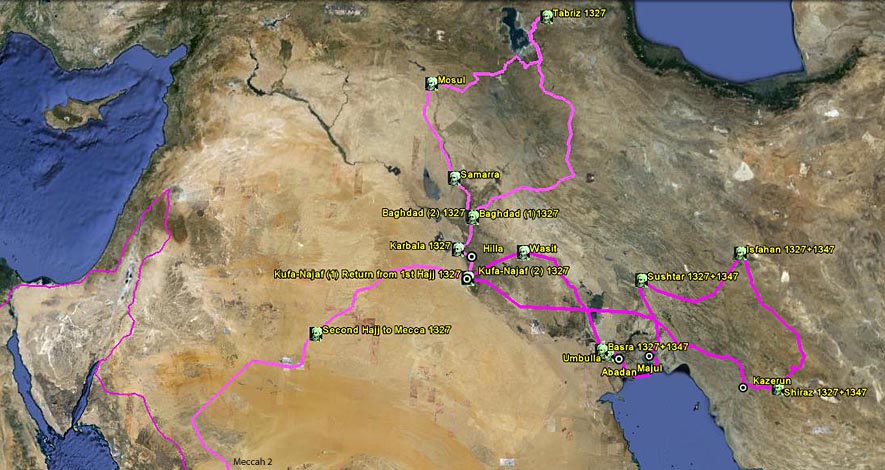
Return to Baghdad - Persia - Tabriz - Second Hajj
Rihla
Book 2
Persia and Second Hajj 1326-27

Return
to Baghdad - Persia - Tabriz - Second Hajj
Rihla
2 , 1327
Kufa-Najaf 1327, Return from first
Hajj
The
town of Ali, who was murdered in Kufa in 661, reportedly by a
Kharijite seeking revenge for the massacre at Nahrawan, is the Great
Saint of the Shi'ite sect of Islam.
We
alighted in the town of Kufa-Najaf. The inhabitants of the town are
all Shi'ites, and at this mausoleum many miracles are performed,
which they regard as substantiating its claim to be the tomb of Ali.
Its people are traders of great enterprise, brave and
generous and excellent company on a journey, but they are fanatical
about Ali. If any of them suffers from illness in the head, hand,
foot, or other part of the body, he makes a model of the member in
gold or silver and brings it to the sanctuary.
After our visit to
the tomb of Caliph Ali, the caravan went on to Baghdad, but I set out
for Basra, in the company of a large troop of the Arab inhabitants of
that country. They are exceedingly brave and it is impossible to
travel in those regions except in their company. Our way lay along
the Euphrates by the place called al-'Idhar, which is a waterlogged
jungle of reeds, inhabited by Arabs noted for their predatory habits.
They are brigands and profess adhesion to the Shi'ite sect. They
attacked a party of darwishes behind us and stripped them of
everything down to their shoes and wooden bowls.
Three days'
march through this district brought us to the town of Wasit.
Rihla
2 , 1327
Wasit 1327
Three
days' march through this district brought us to the town of Wasit.
Its inhabitants are among the best people in 'Iraq— indeed, the
very best of them without qualification.
All the 'Iraqis who
wish to learn how to recite the Koran come here, and our caravan
contained a number of students who had come for that purpose. As the
caravan stayed here three days, I had an opportunity of visiting the
grave of ar-Rifa'i, which is at a village called Umm 'Ubayda, one
day's journey from there. I reached the establishment at noon the
next day and found it to be an enormous monastery, containing
thousands of darwishes.
After the mid-afternoon prayer drums and
kettledrums were beaten and the darwishes began to dance. After this
they prayed the sunset prayer and brought in the meal, consisting of
rice-bread, fish, milk and dates.
After the night prayer they
began to recite their litany. A number of loads of wood had been
brought in and kindled into a flame, and they went into the fire
dancing; some of them rolled in it and others ate it in their mouths
until they had extinguished it entirely. This is the peculiar custom
of the Ahmadi darwishes.
Rihla
2 , 1327
Basra 1327+1347

The
great Arabic library of Basra
Image from emsc.nysed.gov.
"Basra
is one of the metropolitan cities of Iraq and no place excels it in
quantity of palm-groves. The current price of dates in its market is
fourteen pounds to an Iraqi dirham. The qadi sent me a hamper of
dates that a man could scarcely carry; I sold them and received nine
dirhams, and three of those were taken by the porter for carrying the
basket from the house to the market.
The inhabitants of Basra
possess many excellent qualities; they are affable to strangers and
give them their due, so that no stranger ever feels lonely amongst
them. They hold the Friday service in the mosque of 'Ali, but for the
rest of the week it is closed.
I was present once at the
Friday service in this mosque and when the preacher rose to deliver
his discourse he committed many gross errors of grammar. In
astonishment at this I spoke of it to the qadi and this is what he
said to me: "In this town there is not a man left who knows
anything of the science of grammar."
Here is a lesson
for those who will reflect on it--Magnified be He who changes all
things! This Basra, in whose people the mastery of grammar reached
its height, from whose soil sprang its trunk and its branches,
amongst whose inhabitants is numbered the leader whose primacy is
undisputed -- the preacher in this town cannot deliver a discourse
without breaking its rules!"
Rihla
2 , 1327
Umbulla
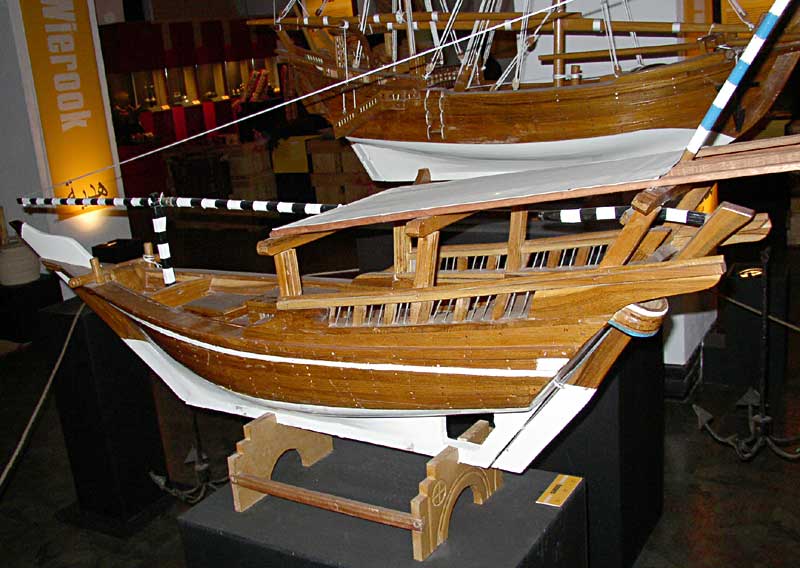
Model
of a Sambuq
Photo Arbeitskreis-historischer-Schiffbau
"At Basra I embarked in a sumbuq, that is a small boat, for Ubulla, which lies ten miles distant. One travels between a constant succession of orchards and palm-groves both to right and left, with merchants sitting in the shade of the trees selling bread, fish, dates, milk and fruit. Ubulla was formerly a large town, frequented by merchants from India and Firs, but it fell into decay and is now a village."
Rihla
2 , 1327
Sushtar
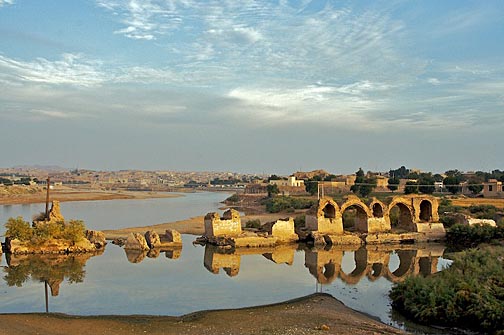
Band-e
Qaisar ("Caesar's") Bridge built by the Romans at Sushtar
Photo from Persian
Wikipedia website
Thereafter
I came to the city of Tuslar [Shushtar] which is situated at the edge
of the plain and the beginning of the mountains. I stayed there
sixteen days at the madrasa of the Shaykh Sharaf ad-Din Musa, one of
the handsomest and most upright of men. He preaches every Friday
after the midday service, and when I heard him, all the preachers
whom I had heard previously in the Hijaz, Syria and Egypt sank in my
estimation, nor have I ever met his equal.
I was present with him
at a gathering of notables, theologians and darwishes in an orchard
on the river-bank. After he had served them all with food, he
delivered a discourse with solemnity and dignity. When he finished,
bits of paper were thrown to him from all sides, for it is a custom
of the Persians to jot down questions on scraps of paper and throw
them to the preacher, who answers them. The shaykh collected them all
and began to answer them one after the other in the most remarkable
and elegant manner.
Rihla
2 , 1327
Isfahan
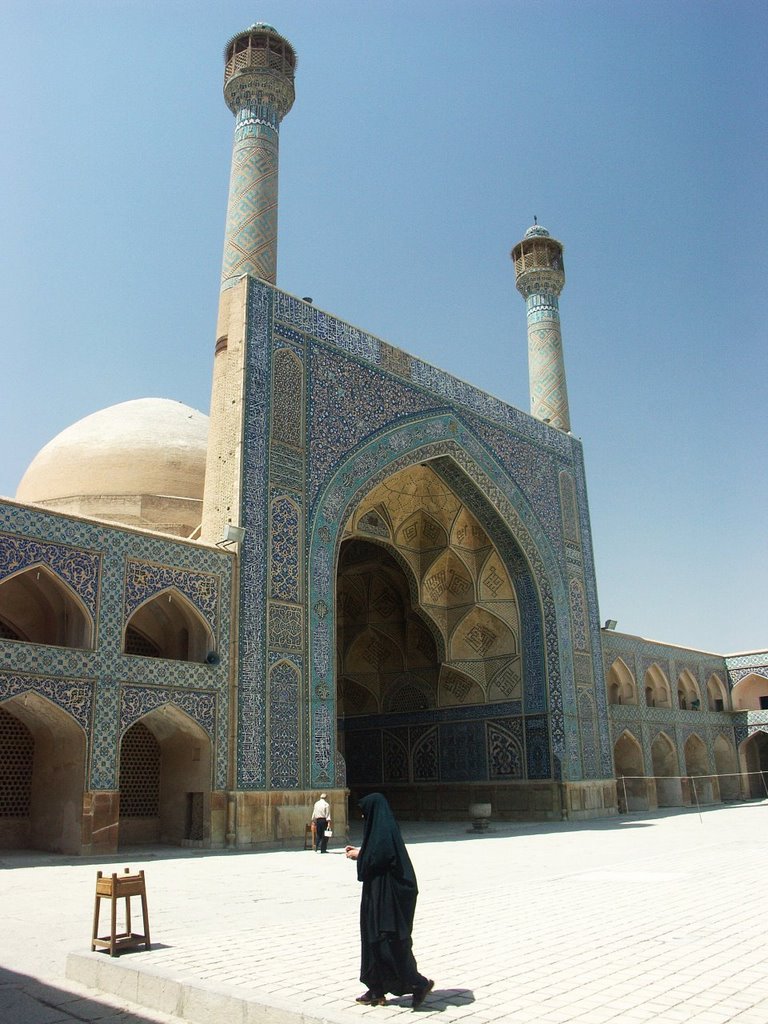
Photo
by Vojta Srejber, Panoramio
Isfahan's oldest mosque, the Masjid-i-Jami, 8th - 17th cent,
Buyid, Seljuk, Safavid.The Friday Mosque as it stands now is the result of continual construction, reconstruction, additions and renovations on the site from around 771 to the end of the twentieth century. Isfahan's architectural splendor, as we know it today, is the work of Armenian master builders under Shah Abbas I (17th cent Safavid) long after ibn Battuta's visit
"Isfahan is one of the largest and fairest of cities, but the greater part of it is now in ruins, as a result of the feud between Sunnis and Shi'ites, which is still raging there."
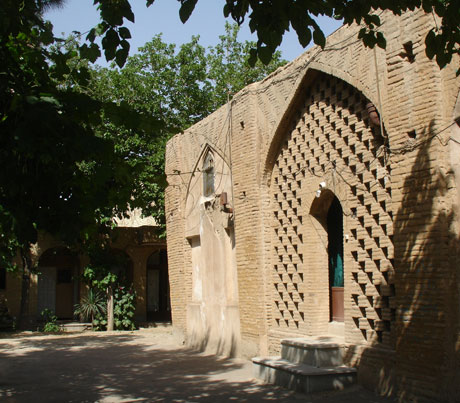
The
Sufi taqqiya (convent), where Ibn Battuta stayed and was initiated
into the Suhrawardi School.
My
lodging at Isfahan was in a convent which is attributed to Shaikh Ali
bin-Sahl. It is held in great veneration. Food is served in it to all
wayfarers, and it has a magnificent bath, paved with marble, and with
qashani tiles on its walls. It is endowed for the service of God, so
that nothing is required of any person who enters it.
The shaikh
of this convent was a pious and scrupulous devotee named Qutb al-Din
Husain. He went to great length in honoring me, showed me generous
hospitality, and presented me with a fine set of garments.
One
day he came to visit me in the part of the hospice where I was
staying. This place looked out over a garden belonging to the shaikh,
and on that day his garments had been washed and spread out in the
garden to dry. Among them I saw a white tunic with a lining, of the
kind called by them hazarmikhi. I admired it and said to myself,
'This is the kind of thing that I was wanting.'
When the shaikh
came into my room, he looked out towards the garden and said to one
of his servants, 'Fetch me that hazarmikhi robe,' then he put it on
me. I threw myself at his feet, kissing them, and begged him to
clothe me also with a skull-cap from his head, and to give me the
same initiation of the Suhrawardi brotherhood that he had received
from his father on the authority of the latter's shaikhs.
He
invested me accordingly, as he had been invested with it by his
father Shams al-Din and his father had been invested with it by his
father Taj al-Din Mahmud, and Mahmud by his father Shihab al-Din Ali
al-Raja, and Ali by the Imam Shihab al-Din Abu Hafs Omar bin-Muhammad
bin-Abdallah al-Suhrawardi.
Rihla
2 , 1327
Shiraz
1327+1347

Text
and photo tabsite.com
Shiraz,
Shah Cheragh Shrine, Syed Amir Ahmad (also called Ahmad ibn Musa),
14th cent
As a city Shiraz was founded in 684 AD, after the Arab armies conquered the Sassanian Empire. The Buyids (945-1055 AD) made Shiraz their capital, building mosques, palaces and a great city wall. The 13th and 14th cent saw Shiraz under the Ilkhanids as a literary center especially famous for its poets Sa'adi and Hafez, both of whom are buried in the city. Like in Isfahan there are many splendid Islamic monuments in Shiraz from its Safavid time (17th cent).
"Shiraz is a densely populated town, well built and admirably planned. Each trade has its own bazaar. Its inhabitants are handsome and clean in their dress. The people of Shiraz are pious and upright, especially the women, who have a strange custom. Every Monday, Thursday, and Friday they meet in the principal mosque to listen to the preacher, one or two thousand of them, carrying fans with which they fan themselves on account of the great heat. I have never seen in any land so great an assembly of women.
Rihla
2 , 1326
Karbala 1327
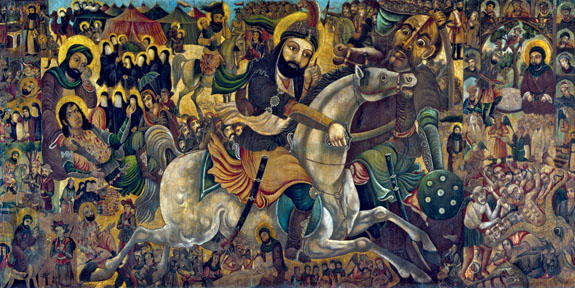
Battle
of Karbala (600) in which Imam Husayn ibn Ali was killed by an army
of Sunni Arabs
photo Brooklyn
Museum
We traveled thence to the town of Karbala, the shrine of al-Husayn, the son of Ali. The surroundings of the tomb and the ceremonies of visitation resemble those of the tomb of Ali at Najaf. In this town too the inhabitants form two factions between whom there is constant fighting, although they are all Shi'ites and descended from the same family, and as a result of their feuds the town is in ruins.
Rihla
2 , 1327
Baghdad 1327
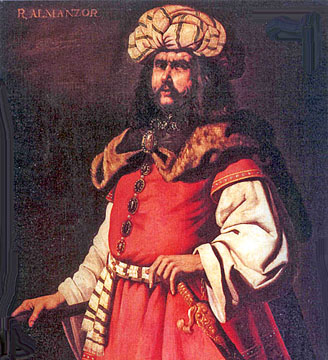
Al-Mansur
painting by Francisco Zubaran (1598 – 1664)
Short History of Baghdad:
762
caliph Abu Ja'far Al-Mansur founds the "Ideal Round City"
8th-
9th cent Baghdad the center of Islamic learning (caliph Harun
al-Rashid)
10th century, the city's population reached almost 2
million
1258 Baghdad was sacked and destroyed by the Il-Khanid
Hülegü (grandson of Genghis Khan)
1401 Baghdad was
again sacked, by Timur ("Tamerlane")
It
is interesting that Battuta attributes the devastation he finds in
Baghdad to the infighting between Shi'its and Sunnis.
Hence
we arrived in Baghdad, the Abode of Peace and Capital of Islam. Here
there are two bridges like at Hilla, on which the people promenade
night and day. The town has eleven cathedral mosques, eight on the
right bank and three on the left, together with very many other
mosques and madrases, only the latter are all in ruins.
The
baths at Baghdad are numerous and of excellent construction. Most of
them are painted with pitch, which has the appearance of black
marble. This pitch is brought from a spring between Kufa and Basra,
from which it flows continually. It gathers at the sides of the
spring like clay and is shoveled up and brought to Baghdad.
Each
establishment has a large number of private bathrooms, every one of
which has also a wash basin in the corner, with two taps supplying
hot and cold water. Every bather is given three towels, one to wear
round his waist when he goes in, another to wear round his waist when
he comes out, and the third to dry himself with. In no town other
than Baghdad have I seen all this elaborate arrangement.
The western part of Baghdad was the earliest to be built, but it is now for the most part in ruins. In spite of that there remain in it still thirteen quarters, each like a city in itself and possessing two or three baths.
Rihla
2 , 1327
Tabriz 1327

Safavid
inspired modern Tabriz rug.
Photo spongobongo.com
I
left Baghdad with the mahallah of Sultan Abu Sa'fd, on purpose to see
the way in which the king's marches are conducted, and traveled with
it for ten days, thereafter accompanying one of the amirs to the town
of Tabriz.
It is their custom to set out with the rising of
the dawn and to encamp in the late forenoon.
Their ceremonial is
as follows: Each of the amirs comes up with his troops, his drums and
his standards, and halts in a position that has been assigned to him,
not a step further, either on the right wing or the left wing. When
they have all taken up their positions and their ranks are set in
perfect order, the king mounts, and the drums, trumpets and fifes are
sounded for the departure. Each of the amirs advances, salutes the
king, and returns to his place; then the chamberlains and the
marshals move forward ahead of the king, followed by the musicians.
These number about a hundred men. Ahead of the musicians there are 10
horsemen, with 10 drums.... On the sultan's right and left during his
march are the great amirs, who number about 50. Each amir has his own
standards, drums and trumpets. Then [come] the sultan's baggage and
baggage-animals and finally the rest of the army."
We
stayed only one night in Tabriz. I passed through the jewelers'
bazaar, and my eyes were dazzled by the varieties of precious stones
that I beheld. They were displayed by beautiful slaves wearing rich
garments with a waist sash of silk, who stood in front of the
merchants, exhibiting the jewels to the wives of the Turks, while the
women were buying them in large quantities and trying to outdo one
another. As a result of all this I witnessed a riot—may God
preserve us from such !
We returned to Baghdad by way of
Mosul and Samarra.
Rihla
2 , 1327
Mosul

Mosul
from the Tigris
Photo art.com
On reaching Mosul I found its pilgrim caravan outside the city setting out for Baghdad and joined them, and returned to Baghdad and received in full what the sultan had ordered.
Rihla
2 , 1327
Samarra
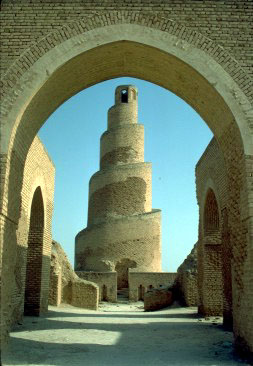
Samarra,
Mosque al-Muttawikil (847-892)
Photo theellisschool.org
On the way we came a place on the Tigris near a fort called al-Ma'shuq, opposite which on the eastern bank, is the town of Surraman-ra'a or Samarra. This town is a total ruin and only a very small part of it remains.
Rihla
2 , 1327
Second Hajj to Mecca 1327

Pilgrims
Caravan on their way to Mecca (painting by Leon Belly)
Photo
sandbox.blog.city.com
"At
Baghdad 1327 [after touring Tabriz and other cities in Iran and Iraq]
I found the pilgrims preparing for the journey, so I went to visit
the governor and asked him for the things which the sultan had
ordered for me. He assigned me the half of a camel-litter and
provisions and water for four persons, writing out an order to that
effect, then sent for the leader of the caravan and commended me to
him.
I had already made the acquaintance of the latter, but our
friendship was strengthened, and I remained under his protection and
favored by his bounty, for he gave me even more than had been ordered
for me."
As we left Kufa with the Hajj caravan I fell
ill of diarrhea and had to be dismounted from the camel many times a
day. The commander of the caravan used to make inqueries for my
condition and give instructions that I should be looked after. My
illness continued until I reached Mecca.
In Mecca I made the
circuit of the Sacred Edifice [the Ka'aba] on arrival, but I was
still so weak that I had to carry out the prescribed ceremonies
seated, and I made the circuit and the ritual visitation of Safa and
Marwa riding on the amir's horse.
Rihla
2, 1327-1330
Mecca(2) 1327-1330

The
route the pilgrims take to the sacred places around Mecca.
Photo:
Wikipedia
My illness continued until I reached Mecca (1327), the Sanctuary of God (may He exalt her honor and greatness!) I made the circuit of the Sacred Edifice [the Ka'aba] on arrival, but I was so weak that I had to carry out the prescribed ceremonies seated, and I made the circuit and the ritual visitation of Safa and Marwa riding on the amir's horse. When we camped at Mina I began to feel relief and to recover from my malady.
At the end of this Pilgrimage I remained at Mecca all that year, giving myself up entirely to pious exercises and leading a most agreeable existence In 1328 I spent another year there, and yet another after that (1329).